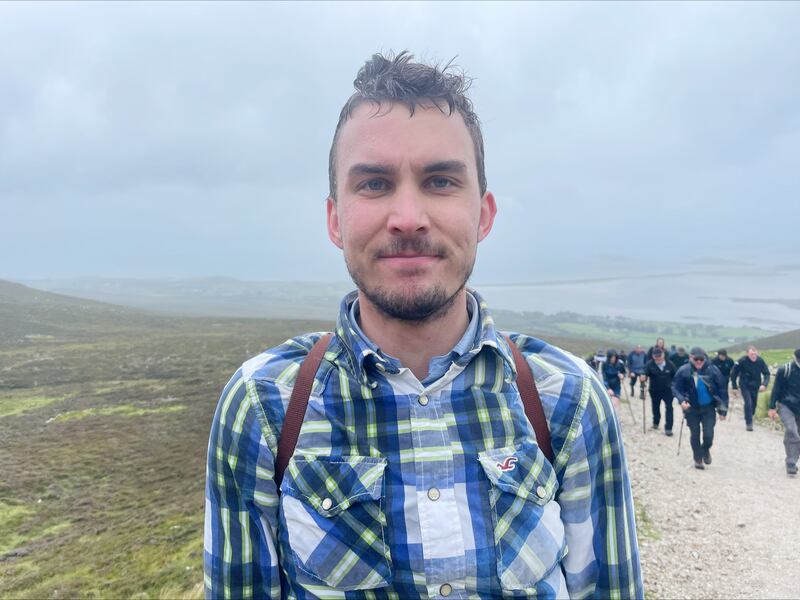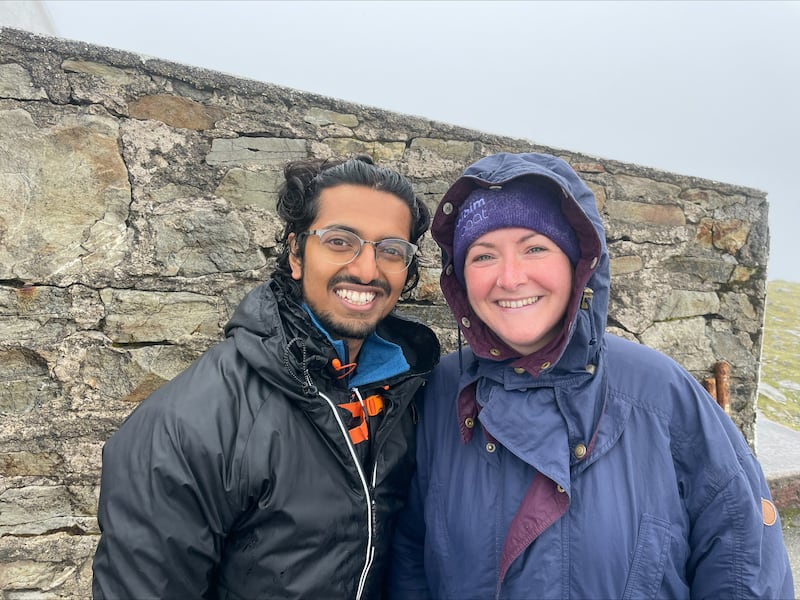Croagh Patrick wears a cloak of low-hanging grey clouds on Reek Sunday, warning those approaching from below. The peak, the objective for the gathering pilgrims continuing the ancient tradition, is hidden in the mountain’s folds.
Ryan O’Kelly (17) is starting up the path, barefoot. Mr O’Kelly, from Jobstown, Tallaght, has never climbed the Co Mayo peak before.
“Fair play to you,” a woman passing him offers.
Mr O’Kelly completed his Leaving Cert a couple weeks ago and is thinking about becoming a teacher.
READ MORE
“I think it’s always something I’ve wanted to do,” he says, clutching a walking stick and wearing an Easter lily pin badge on his rain jacket. “I’m not majorly religious, but I think the idea of giving penance and leaving your troubles at the top, whether its emotional, mental health problems, is a very good thing.”
Another man charges past. “Ah, my barefoot friend,” Mr O’Kelly says, greeting Jacob Kemprud.
Mr Kemprud, an engineer from San Francisco who is living in Edinburgh, is worried that he’s left it late getting up the reek.
In the car park below, a man selling assorted trinkets and religious paraphernalia said people had been out early on Sunday, getting ahead of the bad weather.
The rain is falling sideways now. On this Reek Sunday, his 24th birthday, Mr Kemprud is offering his barefoot trudge to the summit to God, he says.

While in university, Mr Kemprud joined a Christian society because they gave out free food. But then, after an “emotional experience”, he found God.
“I was convinced there was nothing. I was a radical nihilist,” he says, dressed in a flannel shirt and trousers, moving purposefully up the path. “The real moment was when I was there and I was convinced that [God] was there and listening.”
He wept when he found that faith.
Further up the path, Annette Feehan, from Galmoy, Co Kilkenny, is climbing on her own. She’s been up before – about 40 times or so. “I do it for intentions,” Ms Feehan says of the pilgrimage. “Health, family unity, the struggles in the world ... loads of different things.”
Moving further into the mist, Clew Bay disappears behind pilgrims on the ascent. Linked arms and wry quips support those moving towards the top, as the terrain becomes more craggy and the rain more unforgiving. “Dirty day,” one man spits.
And then it appears. On the summit, people share sandwiches and flasks. Children with rain dripping off their noses dart around, pilgrims queue for Confession and Communion.
Julia Healy (34) is trying to catch some shelter by the church on the summit. She isn’t religious, but she does believe in something. “I think it’s important for me and for others to think that somebody or something is on their side ... whether you call that nature, or karma, or you associate a religion with it.”
Ms Healy, who has recently moved to Westport from Galway, has just finished her first Reek Sunday climb with her friend, Pranjal Chitransh (31).
“I really like the climb because it’s got a poetry to it. It’s easy enough at the start, you’ve got a lovely view, and then there’s parts where it’s more flat, a lot of different terrain. Right before you reach the church, you can’t see the church, it’s obscured from view for pretty much the whole climb, it’s getting steeper and steeper, and then you arrive ... It’s a special place.”

At 11am, the Catholic Primate of All Ireland, Archbishop Eamon Martin, begins Mass on the summit, and a crowd huddles in.
Mr Kemprud has made it in time, now wearing a makeshift rain poncho and nursing sore feet.
“Personally, I think it’s more important than ever to connect to spiritual memory,” Archbishop Martin says. “Whenever I climb this mountain, I get a great sense of the generations of faithful people who have come here on pilgrimage every year.
“I think people nowadays have a lot of struggles in their lives, mental health issues, family issues, relationship issues ... the world is still at war. There’s migration, displacement of peoples.”
St Patrick, who is said to have spent 40 days on Croagh Patrick praying, was displaced to Ireland as a young boy, the Archbishop points out.
“I think it’s really important for us to keep connecting with our past in the present and looking to the future,” he adds.
Then it is time to face the descent. The rain doesn’t let up until the bay comes back into view.














